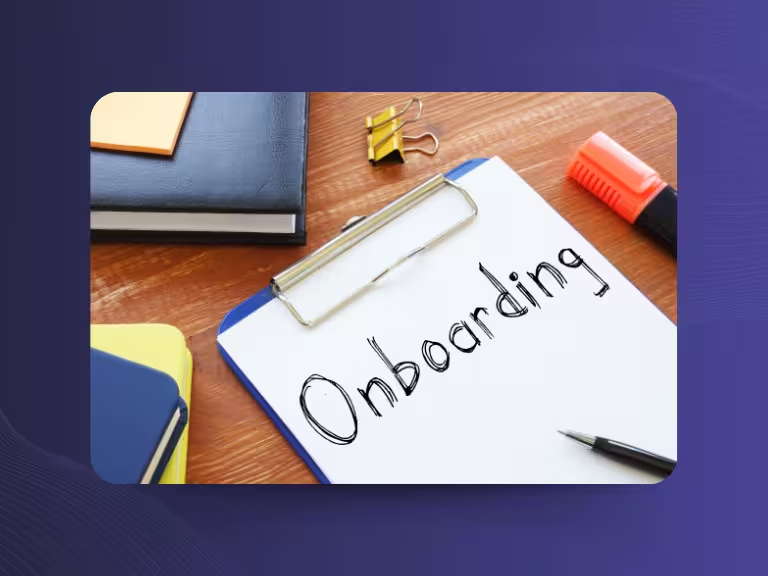Table of Contents
A bad first impression is hard to correct – this also applies to new employees. While many companies still stick to the traditional "Here's your desk, there's the handbook" approach, successful organizations understand the onboarding process as a strategic success factor. Studies show: 69% of employees stay with a company for at least three years when the onboarding is excellent.
The modern onboarding process goes far beyond administrative formalities. It encompasses the holistic integration of new team members – professionally, socially, and culturally. Digital tools, structured feedback mechanisms, and diversity play an increasingly important role.
In this article, you'll learn how to build a thoughtful onboarding process that not only excites new employees but also increases your productivity and reduces turnover. From practical checklists to innovative technologies – we'll show you what really works.
What is the Onboarding Process and Why is it So Important?
Definition and Objectives of Onboarding
Onboarding is more than orientation. It's a systematic process that holistically integrates new employees into the company. While classic orientation often only covers technical aspects, a well-thought-out onboarding process encompasses three central dimensions:
- Operational
- Social
- Cultural
Operational integration conveys the necessary know-how and workflows. Social integration helps build relationships with colleagues and managers. Cultural integration familiarizes new team members with company values, mission, and unwritten rules.
The difference from conventional orientation lies in the strategic approach. A good onboarding process pursues clear goals: faster productivity, higher employee satisfaction, and stronger commitment to the company. The result? Less turnover and motivated team members from the start.
The Phases of Onboarding
Successful onboarding begins even before the first day of work. Pre-boarding includes all preparations: organizing IT equipment, setting up workspaces, sending welcome packages. A technology company from Munich, for example, sends a personalized team video with initial tips and a digital checklist one week before starting work.
The first day of work sets the foundation for the entire employee experience. Here, personal greetings, team introductions, and structured orientation matter. A warm welcome and a well-planned daily schedule reduce nervousness and build trust.
The orientation phase of the first weeks focuses on knowledge building and skill development. Training sessions, courses, and increasingly e-learning modules help employees settle into their roles. At the same time, initial smaller projects should strengthen the sense of self-efficacy.
Continuous development extends over 6-12 months. Regular discussions, feedback rounds, and development opportunities ensure sustainable integration. Many experts emphasize: "Onboarding is not a single event, it's an experience."

Practical Tools: Checklists, Structure, and Roles in Onboarding
Checklists and Structured Processes for Process Security
Without structure, even the best onboarding becomes chaos. Checklists are your best friend. They ensure nothing is forgotten and all stakeholders know what to do.
The administrative checklist covers all formal aspects: employment contracts, privacy statements, IT access, company phone, parking space, and cafeteria card. These points may seem dry, but they form the foundation for a smooth start.
The professional checklist structures knowledge building. What training is necessary? Which software must be learned? Which processes are relevant? More and more companies are using e-learning modules that new employees can work through flexibly.
The social checklist supports integration into the team. This includes introductory rounds, shared lunches, buddy programs, and participation in team meetings. A consulting company from Hamburg, for example, uses Sally to integrate new employees into meetings from the start – the automatic documentation and summarization helps quickly capture and understand relevant information.
The Role of Leaders and Colleagues
The best onboarding process is useless if the people behind it don't participate. Leaders play a crucial role as role models and contact persons. They should consciously take time, communicate expectations clearly, and provide regular feedback.
Colleagues are often the most important helpers in daily work. They know the unwritten rules, know where the best coffee is, and can give practical tips. Buddy programs formalize this support and create reliable contacts.
A strong team environment doesn't happen by itself. It requires conscious efforts: joint projects, informal conversations, and the feeling of being truly welcome. Modern tools like Sally can also help here by automatically documenting meeting content and helping new employees understand important information even if they weren't present at all meetings.
Innovative Approaches and Modern Technologies in Onboarding
Digitalization as an Opportunity for Efficient Onboarding
Digitalization is revolutionizing the onboarding process. E-learning platforms enable location-independent learning at one's own pace. New employees can flexibly familiarize themselves with topics and have constant access to relevant information.
Virtual Reality (VR) opens completely new possibilities. An international technology corporation uses VR to virtually guide new employees through all locations. They can explore workplaces, practice typical scenarios, and get a realistic picture of the company – without traveling.
AI-based onboarding tools automate recurring tasks. They create personalized learning paths, remind about important appointments, and analyze progress. Digital document management ensures all documents are centrally available and nothing gets lost.

Designing Onboarding as a Multimedia Experience
Dry manuals and hour-long presentations are a thing of the past. Modern onboarding relies on interactive formats that motivate and inspire.
Videos create personal connections. A welcome video from the CEO, team introductions, or explanatory videos about important processes make content more tangible. Apps and digital checklists gamify the learning process and create more engagement.
Sally also comes into play here: The tool can automatically create meeting documentation and summarize important information. This allows new employees to retrospectively understand what was discussed in important meetings and not miss any relevant information – a real added value for knowledge management in onboarding.
Sustainability: Employee Retention, Feedback, and Diversity in the Onboarding Process
Long-term Employee Retention Through Good Onboarding
A well-thought-out onboarding process is an investment in the future. It builds trust from day one and creates an emotional connection to the company. Employees who feel well-integrated are more satisfied, productive, and stay longer.
Relationship building starts before the first day of work and continues consistently. Regular conversations, development opportunities, and the feeling of being valued are crucial for long-term retention.
Positive effects show in measurable metrics: lower turnover rates, higher employee satisfaction, and better ratings as an employer. A good onboarding process pays off not only humanly but also economically.
Feedback Mechanisms for Continuous Improvement
Feedback is the key to continuous improvement. Regular surveys of new employees reveal weaknesses and show improvement opportunities. Digital tools make these surveys simple and efficient.
An open communication culture encourages honest feedback. New employees should feel they can freely express their opinions without fearing negative consequences. Their outside perspective is often particularly valuable.
The adaptability of the process is also important. Feedback should not only be collected but also implemented. A living onboarding process continuously evolves and adapts to new requirements.
Diversity and Inclusion as an Integral Part of Onboarding
Diversity and inclusion are not side aspects but central success factors. An inclusive onboarding process considers different cultural backgrounds, needs, and experiences.
Barrier-free and multilingual materials ensure that all new employees have equal access to important information. Flexible formats consider different learning styles and life situations.
Sensitizing the team to diversity and equal opportunities is an important component. Workshops, training sessions, and open discussions create awareness and promote an inclusive work environment. This benefits everyone – new employees and the entire team.
Conclusion: How to Achieve a Successful Onboarding Process
A successful onboarding process is far more than extended orientation – it's a strategic success factor for every company. The holistic support of new employees from preparation to long-term development pays off in higher productivity, lower turnover, and stronger employee retention.
The key lies in the structured approach: Well-thought-out checklists, active involvement of leaders and teams, and skillful use of digital tools create a complete experience. Modern technologies like e-learning, VR, or automated documentation tools not only increase efficiency but also the quality of the employee experience.
Particularly important is the long-term perspective: Continuous feedback, attention to diversity aspects, and constant development of the process ensure sustainable success. Companies that invest in a well-thought-out onboarding process create not only satisfied employees but also a decisive competitive advantage in the job market.
The message is clear: Onboarding is an investment that pays off – for new employees and for the entire company.

Try meeting transcription now!
Experience how effortless meeting notes can be – try Sally free for 4 weeks.
Test NowOr: Arrange a Demo Appointment

.avif)



